MaryAnn Bernal's Blog, page 139
November 1, 2015
History Trivia - All Saints Day
November 1
The origins of the holiday commemorating all the saints of the church are obscure, but by the mid-eighth century, November 1st was the day to honor all known and unknown saints in the Catholic Church. In 837, its general observance was ordered by Pope Gregory IV. The date may have been selected for its coincidence with pagan observations of the harvest, including the ancient Celtic festival of Samhain and the ancient Finnish celebration of Kekri.

The origins of the holiday commemorating all the saints of the church are obscure, but by the mid-eighth century, November 1st was the day to honor all known and unknown saints in the Catholic Church. In 837, its general observance was ordered by Pope Gregory IV. The date may have been selected for its coincidence with pagan observations of the harvest, including the ancient Celtic festival of Samhain and the ancient Finnish celebration of Kekri.

Published on November 01, 2015 03:00
Project Launched to Revive the Colossus of Rhodes, Wonder of the Ancient World
Ancient Origins
 A multinational team of professionals has launched an ambitious ‘Colossus of Rhodes Project’ to revive the tallest statue of the Hellenistic period. The planned 150-meter tall colossus would house a cutting edge museum containing thousands of ancient artifacts.
A multinational team of professionals has launched an ambitious ‘Colossus of Rhodes Project’ to revive the tallest statue of the Hellenistic period. The planned 150-meter tall colossus would house a cutting edge museum containing thousands of ancient artifacts.
A Statue to Honor VictoryThe Colossus of Rhodes was the last of the seven wonders to be completed, it was a statue built to thank the gods for victory over an invading enemy.
In 357 BC, the Greek island of Rhodes was conquered by Mausolus of Halicarnassus but fell into Persian hands in 340 BC and was finally captured by Alexander the Great in 332 BC. In the late fourth century BC, Rhodes allied with Ptolemy I of Egypt against their common enemy, Antigonus I Monophthalmus of Macedonia. In 305 BC, Antigonus sent his son Demetrius to capture and punish the city of Rhodes for its alliance with Egypt. He attacked the island with 40,000 men but a relief force of ships sent by Ptolemy arrived in 304 BC, and Antigonus’ army abandoned the siege, leaving behind most of their siege equipment. To celebrate their victory, the Rhodians sold the equipment and used the money to build a huge statue, to their sun god, Helios, called the Colossus of Rhodes. The Colossus was said to have been fashioned from the melted down bronze weapons of the defeated invaders.
The statue stood for only 56 years until the island of Rhodes was hit by an earthquake in 226 BC, destroying much of the city and causing the statue to break off at the knees and topple over into pieces. The statue would go untouched for 900 years or until the Arab invasion of Rhodes in 654 AD. The remains are said to have been melted down to be used as coins, tools, and weapons.
 The Colossus of Rhodes, depicted in this hand-colored engraving, was built about 280 BC. Standing 30 meters (100 feet) high, it was built to guard the entrance to the harbor at Rhodes. The ancient Greeks and Romans considered it to be one of the Seven Wonders of the World.
Public Domain
2,200-Year-Old Statue to be Revived AgainA team of professionals, including architect Ari A. Palla, archaeologist Christos Giannas and public relations-marketing professional Dionisis Mpotsas from Greece, civil engineer Enrique Fernández Menendez and economist Matilda Palla from Spain, architect Ombretta Iannone from Italy, and civil engineer Eral Dupi from the United Kingdom, is now planning to revive the Colossus as part of a European initiative.
The Colossus of Rhodes, depicted in this hand-colored engraving, was built about 280 BC. Standing 30 meters (100 feet) high, it was built to guard the entrance to the harbor at Rhodes. The ancient Greeks and Romans considered it to be one of the Seven Wonders of the World.
Public Domain
2,200-Year-Old Statue to be Revived AgainA team of professionals, including architect Ari A. Palla, archaeologist Christos Giannas and public relations-marketing professional Dionisis Mpotsas from Greece, civil engineer Enrique Fernández Menendez and economist Matilda Palla from Spain, architect Ombretta Iannone from Italy, and civil engineer Eral Dupi from the United Kingdom, is now planning to revive the Colossus as part of a European initiative.
 Planned reconstruction of the Colossus of Rhodes on the Island of Rhodes, Greece (
Colossus of Rhodes Project
)Putting Rhodes Back on the MapOne of the highlights of the impressive structure will be a museum that houses thousands of ancient artifacts, that until now, have been gathering dust in museums and archives on the island of Rhodes.
Planned reconstruction of the Colossus of Rhodes on the Island of Rhodes, Greece (
Colossus of Rhodes Project
)Putting Rhodes Back on the MapOne of the highlights of the impressive structure will be a museum that houses thousands of ancient artifacts, that until now, have been gathering dust in museums and archives on the island of Rhodes.
The primary aim of the project is to put Rhodes “back on the map”, to provide a massive boost to tourism, and in the process provide new job opportunities and a growth to both the local and national economy. Projections anticipate a revenue growth of over 2 billion euros and an increase to the number of visitors by 150%. Moreover, the project team writes,
Featured image: Engraving of the Colossus of Rhodes. Paul K / Flickr
By: April Holloway
 A multinational team of professionals has launched an ambitious ‘Colossus of Rhodes Project’ to revive the tallest statue of the Hellenistic period. The planned 150-meter tall colossus would house a cutting edge museum containing thousands of ancient artifacts.
A multinational team of professionals has launched an ambitious ‘Colossus of Rhodes Project’ to revive the tallest statue of the Hellenistic period. The planned 150-meter tall colossus would house a cutting edge museum containing thousands of ancient artifacts.A Statue to Honor VictoryThe Colossus of Rhodes was the last of the seven wonders to be completed, it was a statue built to thank the gods for victory over an invading enemy.
In 357 BC, the Greek island of Rhodes was conquered by Mausolus of Halicarnassus but fell into Persian hands in 340 BC and was finally captured by Alexander the Great in 332 BC. In the late fourth century BC, Rhodes allied with Ptolemy I of Egypt against their common enemy, Antigonus I Monophthalmus of Macedonia. In 305 BC, Antigonus sent his son Demetrius to capture and punish the city of Rhodes for its alliance with Egypt. He attacked the island with 40,000 men but a relief force of ships sent by Ptolemy arrived in 304 BC, and Antigonus’ army abandoned the siege, leaving behind most of their siege equipment. To celebrate their victory, the Rhodians sold the equipment and used the money to build a huge statue, to their sun god, Helios, called the Colossus of Rhodes. The Colossus was said to have been fashioned from the melted down bronze weapons of the defeated invaders.
The statue stood for only 56 years until the island of Rhodes was hit by an earthquake in 226 BC, destroying much of the city and causing the statue to break off at the knees and topple over into pieces. The statue would go untouched for 900 years or until the Arab invasion of Rhodes in 654 AD. The remains are said to have been melted down to be used as coins, tools, and weapons.
 The Colossus of Rhodes, depicted in this hand-colored engraving, was built about 280 BC. Standing 30 meters (100 feet) high, it was built to guard the entrance to the harbor at Rhodes. The ancient Greeks and Romans considered it to be one of the Seven Wonders of the World.
Public Domain
2,200-Year-Old Statue to be Revived AgainA team of professionals, including architect Ari A. Palla, archaeologist Christos Giannas and public relations-marketing professional Dionisis Mpotsas from Greece, civil engineer Enrique Fernández Menendez and economist Matilda Palla from Spain, architect Ombretta Iannone from Italy, and civil engineer Eral Dupi from the United Kingdom, is now planning to revive the Colossus as part of a European initiative.
The Colossus of Rhodes, depicted in this hand-colored engraving, was built about 280 BC. Standing 30 meters (100 feet) high, it was built to guard the entrance to the harbor at Rhodes. The ancient Greeks and Romans considered it to be one of the Seven Wonders of the World.
Public Domain
2,200-Year-Old Statue to be Revived AgainA team of professionals, including architect Ari A. Palla, archaeologist Christos Giannas and public relations-marketing professional Dionisis Mpotsas from Greece, civil engineer Enrique Fernández Menendez and economist Matilda Palla from Spain, architect Ombretta Iannone from Italy, and civil engineer Eral Dupi from the United Kingdom, is now planning to revive the Colossus as part of a European initiative.“The aim of the project is not to propose a copy of the original, bronze, 40 meters high structure, but to arouse the same emotions that visitors felt, more than 2200 years ago,” the project team writes on their website. “This 150 meters-high structure is born to be a museum, a cultural center, a library but, most of all, must regain its original function: a giant lighthouse, a point of reference for boats in the night, which project a light that can be seen more than 56 km away in open sea, even from the coasts of Turkey… Its “skin” will be covered with solar panels, providing 100% autonomy: The God of Sun which lives only thanks to solar energy.”
 Planned reconstruction of the Colossus of Rhodes on the Island of Rhodes, Greece (
Colossus of Rhodes Project
)Putting Rhodes Back on the MapOne of the highlights of the impressive structure will be a museum that houses thousands of ancient artifacts, that until now, have been gathering dust in museums and archives on the island of Rhodes.
Planned reconstruction of the Colossus of Rhodes on the Island of Rhodes, Greece (
Colossus of Rhodes Project
)Putting Rhodes Back on the MapOne of the highlights of the impressive structure will be a museum that houses thousands of ancient artifacts, that until now, have been gathering dust in museums and archives on the island of Rhodes.The primary aim of the project is to put Rhodes “back on the map”, to provide a massive boost to tourism, and in the process provide new job opportunities and a growth to both the local and national economy. Projections anticipate a revenue growth of over 2 billion euros and an increase to the number of visitors by 150%. Moreover, the project team writes,
“It will become a great example for all young people in Europe who suffer from the consequences of the economic crisis.”An impressive video showing both the outside and inside of the planned Colossus is below.
Featured image: Engraving of the Colossus of Rhodes. Paul K / Flickr
By: April Holloway
Published on November 01, 2015 03:00
History Trivia - Vikings seize control of Eboracum (York)
November 1

193 Pertinax became emperor of Rome whose reign lasted three months. He was known as the first emperor of the tumultuous Year of the Five Emperors. He tried to restore discipline in the Praetorian Guards who rebelled and killed him.

866 the Vikings seized control of Eboracum (York), the first major city to fall in their conquest of England.
1512 Michelangelo's paintings on the ceiling of Sistine Chapel was first exhibited.

193 Pertinax became emperor of Rome whose reign lasted three months. He was known as the first emperor of the tumultuous Year of the Five Emperors. He tried to restore discipline in the Praetorian Guards who rebelled and killed him.

866 the Vikings seized control of Eboracum (York), the first major city to fall in their conquest of England.

1512 Michelangelo's paintings on the ceiling of Sistine Chapel was first exhibited.
Published on November 01, 2015 01:30
October 31, 2015
3,500-Year-Old Unplundered Warrior Tomb with Huge Treasure Hoard found in Greece
Ancient Origins
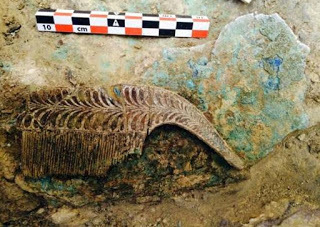 Archaeologists in Greece have made a rare and exciting discovery – an ancient unlooted tomb with the remains of an unknown warrior and a huge hoard of treasure. The Greek Ministry of Culture announced that it is the most important treasure to have been discovered in 65 years.
Archaeologists in Greece have made a rare and exciting discovery – an ancient unlooted tomb with the remains of an unknown warrior and a huge hoard of treasure. The Greek Ministry of Culture announced that it is the most important treasure to have been discovered in 65 years.
The Ministry of Culture announced the finding today, revealing that two US archaeologists, Jack L. Davis and Sharon R. Stocker from the University of Cincinnati, made the discovery while excavating the 3,500-year-old Palace of Nestor on Greece’s Peloponnese peninsula.
The Palace of Nestor, located at the top of the hill of Epano Englianos, near Pylos, is the best preserved Mycenaean Greek palace discovered. It once consisted of a two-storey building with reception rooms, baths, workshops, store rooms, and an established sewage system.
 Photo of Nestor’s Palace taken in 2010 (
public domain
).The tomb, which measures 2.4 meters in length and 1.5 meters in width, was discovered on the site of the palace complex. However, it had been placed there many years before the palace was built. Surprisingly, the tomb had not been looted in antiquity, unlike most of the other Mycenaean-era tombs found to date.
Photo of Nestor’s Palace taken in 2010 (
public domain
).The tomb, which measures 2.4 meters in length and 1.5 meters in width, was discovered on the site of the palace complex. However, it had been placed there many years before the palace was built. Surprisingly, the tomb had not been looted in antiquity, unlike most of the other Mycenaean-era tombs found to date.
Inside the tomb, archaeologists discovered the remains of a wooden coffin containing the skeleton of an unknown warrior, aged between 30 and 35 years old. Next to him were his weapons – a bronze sword with a gold and ivory handle and a gold-hilted dagger. Considering his place of burial and the treasures he was buried with, he is believed to have been a person of great importance.
According to the Ministry of Culture, the treasures also included gold rings, an ornate string of pearls, 50 Minoan seal stones carved with imagery of goddesses, silver vases, gold cups, a bronze mirror, ivory combs, an ivory plaque carved with a griffin, and Minoan-style gold jewelry decorated with figures of deities, animals, and floral motifs.
 Bronze mirror with an ivory handle found in the grave of the warrior. Department of Classics / University of Cincinnati.Many of the artifacts found in the tomb have been traced to Crete, the island upon which the Minoan civilization arose. James C. Wright, the director of the American School of Classical Studies at Athens, told the New York Times that the finding of the tomb “will help scholars understand how the state cultures that developed in Crete were adopted into what became the Mycenaean palace culture on the mainland.”
Bronze mirror with an ivory handle found in the grave of the warrior. Department of Classics / University of Cincinnati.Many of the artifacts found in the tomb have been traced to Crete, the island upon which the Minoan civilization arose. James C. Wright, the director of the American School of Classical Studies at Athens, told the New York Times that the finding of the tomb “will help scholars understand how the state cultures that developed in Crete were adopted into what became the Mycenaean palace culture on the mainland.”
 Artifacts recovered from the grave of the ancient warrior. Greek Ministry of Culture.Archaeologists now plan to carry out a DNA analysis on the warrior’s remains to try to determine his origin. They also plan to carry out radiocarbon tests on the plant material recovered from the tomb, which may allow more accurate dating of the burial.
Artifacts recovered from the grave of the ancient warrior. Greek Ministry of Culture.Archaeologists now plan to carry out a DNA analysis on the warrior’s remains to try to determine his origin. They also plan to carry out radiocarbon tests on the plant material recovered from the tomb, which may allow more accurate dating of the burial.
Featured image: An ivory comb found in the 3,500 years old warrior tomb unearthed in the Peloponnese region of Greece. Greek Ministry of Culture.
By April Holloway
 Archaeologists in Greece have made a rare and exciting discovery – an ancient unlooted tomb with the remains of an unknown warrior and a huge hoard of treasure. The Greek Ministry of Culture announced that it is the most important treasure to have been discovered in 65 years.
Archaeologists in Greece have made a rare and exciting discovery – an ancient unlooted tomb with the remains of an unknown warrior and a huge hoard of treasure. The Greek Ministry of Culture announced that it is the most important treasure to have been discovered in 65 years.The Ministry of Culture announced the finding today, revealing that two US archaeologists, Jack L. Davis and Sharon R. Stocker from the University of Cincinnati, made the discovery while excavating the 3,500-year-old Palace of Nestor on Greece’s Peloponnese peninsula.
The Palace of Nestor, located at the top of the hill of Epano Englianos, near Pylos, is the best preserved Mycenaean Greek palace discovered. It once consisted of a two-storey building with reception rooms, baths, workshops, store rooms, and an established sewage system.
 Photo of Nestor’s Palace taken in 2010 (
public domain
).The tomb, which measures 2.4 meters in length and 1.5 meters in width, was discovered on the site of the palace complex. However, it had been placed there many years before the palace was built. Surprisingly, the tomb had not been looted in antiquity, unlike most of the other Mycenaean-era tombs found to date.
Photo of Nestor’s Palace taken in 2010 (
public domain
).The tomb, which measures 2.4 meters in length and 1.5 meters in width, was discovered on the site of the palace complex. However, it had been placed there many years before the palace was built. Surprisingly, the tomb had not been looted in antiquity, unlike most of the other Mycenaean-era tombs found to date.Inside the tomb, archaeologists discovered the remains of a wooden coffin containing the skeleton of an unknown warrior, aged between 30 and 35 years old. Next to him were his weapons – a bronze sword with a gold and ivory handle and a gold-hilted dagger. Considering his place of burial and the treasures he was buried with, he is believed to have been a person of great importance.
According to the Ministry of Culture, the treasures also included gold rings, an ornate string of pearls, 50 Minoan seal stones carved with imagery of goddesses, silver vases, gold cups, a bronze mirror, ivory combs, an ivory plaque carved with a griffin, and Minoan-style gold jewelry decorated with figures of deities, animals, and floral motifs.
 Bronze mirror with an ivory handle found in the grave of the warrior. Department of Classics / University of Cincinnati.Many of the artifacts found in the tomb have been traced to Crete, the island upon which the Minoan civilization arose. James C. Wright, the director of the American School of Classical Studies at Athens, told the New York Times that the finding of the tomb “will help scholars understand how the state cultures that developed in Crete were adopted into what became the Mycenaean palace culture on the mainland.”
Bronze mirror with an ivory handle found in the grave of the warrior. Department of Classics / University of Cincinnati.Many of the artifacts found in the tomb have been traced to Crete, the island upon which the Minoan civilization arose. James C. Wright, the director of the American School of Classical Studies at Athens, told the New York Times that the finding of the tomb “will help scholars understand how the state cultures that developed in Crete were adopted into what became the Mycenaean palace culture on the mainland.” Artifacts recovered from the grave of the ancient warrior. Greek Ministry of Culture.Archaeologists now plan to carry out a DNA analysis on the warrior’s remains to try to determine his origin. They also plan to carry out radiocarbon tests on the plant material recovered from the tomb, which may allow more accurate dating of the burial.
Artifacts recovered from the grave of the ancient warrior. Greek Ministry of Culture.Archaeologists now plan to carry out a DNA analysis on the warrior’s remains to try to determine his origin. They also plan to carry out radiocarbon tests on the plant material recovered from the tomb, which may allow more accurate dating of the burial.Featured image: An ivory comb found in the 3,500 years old warrior tomb unearthed in the Peloponnese region of Greece. Greek Ministry of Culture.
By April Holloway
Published on October 31, 2015 02:00
History Trivia - All Hallows' Eve
October 31

Historian Nicholas Rogers on the origin of All Hallows' Eve: while some folklorists have detected its origins in the Roman feast of Pomona, the goddess of fruits and seeds, or in the festival of the dead called Parentalia, it is more typically linked to the Celtic festival of Samhain, whose original spelling was Samuin. The name is derived from Old Irish and means roughly "summer's end". A similar festival was held by the ancient Britons and is known as Calan Gaeaf.

The festival of Samhain celebrates the end of the "lighter half" of the year and beginning of the "darker half", and is sometimes regarded as the "Celtic New Year".

The ancient Celts believed that the border between this world and the Otherworld became thin on Samhain, allowing spirits (both harmless and harmful) to pass through. The family's ancestors were honored and invited home while harmful spirits were warded off. It is believed that the need to ward off harmful spirits led to the wearing of costumes and masks.

Historian Nicholas Rogers on the origin of All Hallows' Eve: while some folklorists have detected its origins in the Roman feast of Pomona, the goddess of fruits and seeds, or in the festival of the dead called Parentalia, it is more typically linked to the Celtic festival of Samhain, whose original spelling was Samuin. The name is derived from Old Irish and means roughly "summer's end". A similar festival was held by the ancient Britons and is known as Calan Gaeaf.

The festival of Samhain celebrates the end of the "lighter half" of the year and beginning of the "darker half", and is sometimes regarded as the "Celtic New Year".

The ancient Celts believed that the border between this world and the Otherworld became thin on Samhain, allowing spirits (both harmless and harmful) to pass through. The family's ancestors were honored and invited home while harmful spirits were warded off. It is believed that the need to ward off harmful spirits led to the wearing of costumes and masks.
Published on October 31, 2015 00:30
October 30, 2015
Archaeologists identify Temple of Hatshepsut, the female Pharaoh the ancients tried to erase
Ancient Origins
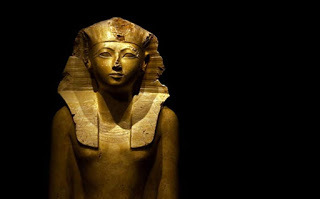 King Thutmose III, sixth Pharaoh of the 18th Dynasty in Ancient Egypt, tried to erase all memory of Hatshepsut, the “Woman Who Was King”, but he was unsuccessful as traces of this powerful female Pharaoh have remained. Now more evidence of her reign has been found, as archaeologists have discovered a temple with inscriptions to Hatshepsut.
King Thutmose III, sixth Pharaoh of the 18th Dynasty in Ancient Egypt, tried to erase all memory of Hatshepsut, the “Woman Who Was King”, but he was unsuccessful as traces of this powerful female Pharaoh have remained. Now more evidence of her reign has been found, as archaeologists have discovered a temple with inscriptions to Hatshepsut.
Polish archaeologists were working at a temple in the ancient Gebelein complex 30 kilometers (18.6 miles) southwest of Luxor, when they identified a temple dedicated to Hathor and possibly Amun-Ra, which appears to have been commissioned by Hatshepsut. According to a new report at Science & Scholarship in Poland , the temple has been known for some time but archaeologists have eschewed studying it until now, perhaps because of the deteriorated condition of the artworks.
The archaeologists, led by Wojciech Ejsmond, believe it is possible the temple was built during Hatshepsut’s reign in the 15th century BC.
It is somewhat amazing that any indications of gods invoked earlier than the reign of Pharaoh Akhenaten of the 14th century BC survived because he went on an iconoclastic spree to instead promote his favorite god—Aten, the sun god. Also, kings would hammer out previous rulers’ names and instead have their own names and attributes carved into rock surfaces of temples and other buildings. This was true especially for Hatshepsut, whose stepson Thutmose III (also known as Tuthmosis III), tried to erase her from history. However, the attempt to eradicate her from memory only fueled the desire of modern civilizations to know more about her.
 Hathor is the cow-headed goddess at right in this image from the ancient Egyptian Book of the Dead. (
Wikimedia Commons
)The scholars believe the construction of the temple happened during Hatshepsut’s reign. Fragments of hieroglyphs with feminine word endings and placement of a cartouche indicate the temple was hers, the article states.
Hathor is the cow-headed goddess at right in this image from the ancient Egyptian Book of the Dead. (
Wikimedia Commons
)The scholars believe the construction of the temple happened during Hatshepsut’s reign. Fragments of hieroglyphs with feminine word endings and placement of a cartouche indicate the temple was hers, the article states.
Hatshepsut was the longest reigning female pharaoh. Egypt’s economy flourished during her rule. She was known as “The Woman Who Was King” and directed the construction and repairs of many buildings, memorials and temples.
 Gebelein is a complex of archaeological sites known for many years. This relief from Gebeline showing the jackal-headed-god Wepwawet and the earth-deity Geb was acquired by Henry Walters in 1925. (
Wikimedia Commons
)Born in 1508 BC, Hatshepsut was the only child of Egyptian king Thutmose I and his principal wife and queen, Ahmose. When Hatshepsut was 12, her father died. She married her half-brother Thutmose II and assumed the role of principal wife and queen. She remained Thutmose II’s queen until he died 15 years later, leaving Hatshepsut a widow at 27. Hatshepsut and Thutmose II had one child together – a daughter named Neferure. Thutmose II also had a son, his heir Thutmose III, born to a concubine. Thutmose III was an infant upon Thutmose II’s death, so Hatshepsut served as his regent.
Gebelein is a complex of archaeological sites known for many years. This relief from Gebeline showing the jackal-headed-god Wepwawet and the earth-deity Geb was acquired by Henry Walters in 1925. (
Wikimedia Commons
)Born in 1508 BC, Hatshepsut was the only child of Egyptian king Thutmose I and his principal wife and queen, Ahmose. When Hatshepsut was 12, her father died. She married her half-brother Thutmose II and assumed the role of principal wife and queen. She remained Thutmose II’s queen until he died 15 years later, leaving Hatshepsut a widow at 27. Hatshepsut and Thutmose II had one child together – a daughter named Neferure. Thutmose II also had a son, his heir Thutmose III, born to a concubine. Thutmose III was an infant upon Thutmose II’s death, so Hatshepsut served as his regent.
This was highly unusual. Egypt’s gods had supposedly decreed that the king’s role could never be fulfilled by a woman ruling on her own. But Hatshepsut refused to submit to this and in around 1437 BC, she had herself crowned as pharaoh, changing her name from the female version Hatshepsut—which means Foremost of the Noble Ladies—to the male version, Hatshepsu.
The excavations of the temple are part of a multi-discipline study of the Gebelein complex, which was on ancient Egyptian maps and may have had a capital of one of the early Egyptian states 5,000 years ago that led to the rise of the pharaohs’ civilization, the article states.
Featured image: Hatshepsut by catch22/deviantart
By Mark Miller
 King Thutmose III, sixth Pharaoh of the 18th Dynasty in Ancient Egypt, tried to erase all memory of Hatshepsut, the “Woman Who Was King”, but he was unsuccessful as traces of this powerful female Pharaoh have remained. Now more evidence of her reign has been found, as archaeologists have discovered a temple with inscriptions to Hatshepsut.
King Thutmose III, sixth Pharaoh of the 18th Dynasty in Ancient Egypt, tried to erase all memory of Hatshepsut, the “Woman Who Was King”, but he was unsuccessful as traces of this powerful female Pharaoh have remained. Now more evidence of her reign has been found, as archaeologists have discovered a temple with inscriptions to Hatshepsut.Polish archaeologists were working at a temple in the ancient Gebelein complex 30 kilometers (18.6 miles) southwest of Luxor, when they identified a temple dedicated to Hathor and possibly Amun-Ra, which appears to have been commissioned by Hatshepsut. According to a new report at Science & Scholarship in Poland , the temple has been known for some time but archaeologists have eschewed studying it until now, perhaps because of the deteriorated condition of the artworks.
The archaeologists, led by Wojciech Ejsmond, believe it is possible the temple was built during Hatshepsut’s reign in the 15th century BC.
It is somewhat amazing that any indications of gods invoked earlier than the reign of Pharaoh Akhenaten of the 14th century BC survived because he went on an iconoclastic spree to instead promote his favorite god—Aten, the sun god. Also, kings would hammer out previous rulers’ names and instead have their own names and attributes carved into rock surfaces of temples and other buildings. This was true especially for Hatshepsut, whose stepson Thutmose III (also known as Tuthmosis III), tried to erase her from history. However, the attempt to eradicate her from memory only fueled the desire of modern civilizations to know more about her.
“Images of many deities were destroyed in antiquity,” the report states. “Pharaoh Akhenaten … promoted the worship of one god, whose symbol was the solar disk. Depictions of other gods who did not have solar aspects were destroyed during his rule. The Goddess Hathor was associated with the sun, so her depictions were spared. … ‘The most puzzling was the lack of royal names in the temple. Rulers of ancient Egypt loved to put their names on the walls of temples exposed to the public view. Sometimes they would destroy the names of previous kings to put their own in these places,’ added Wojciech Ejsmond.”
 Hathor is the cow-headed goddess at right in this image from the ancient Egyptian Book of the Dead. (
Wikimedia Commons
)The scholars believe the construction of the temple happened during Hatshepsut’s reign. Fragments of hieroglyphs with feminine word endings and placement of a cartouche indicate the temple was hers, the article states.
Hathor is the cow-headed goddess at right in this image from the ancient Egyptian Book of the Dead. (
Wikimedia Commons
)The scholars believe the construction of the temple happened during Hatshepsut’s reign. Fragments of hieroglyphs with feminine word endings and placement of a cartouche indicate the temple was hers, the article states.Hatshepsut was the longest reigning female pharaoh. Egypt’s economy flourished during her rule. She was known as “The Woman Who Was King” and directed the construction and repairs of many buildings, memorials and temples.
 Gebelein is a complex of archaeological sites known for many years. This relief from Gebeline showing the jackal-headed-god Wepwawet and the earth-deity Geb was acquired by Henry Walters in 1925. (
Wikimedia Commons
)Born in 1508 BC, Hatshepsut was the only child of Egyptian king Thutmose I and his principal wife and queen, Ahmose. When Hatshepsut was 12, her father died. She married her half-brother Thutmose II and assumed the role of principal wife and queen. She remained Thutmose II’s queen until he died 15 years later, leaving Hatshepsut a widow at 27. Hatshepsut and Thutmose II had one child together – a daughter named Neferure. Thutmose II also had a son, his heir Thutmose III, born to a concubine. Thutmose III was an infant upon Thutmose II’s death, so Hatshepsut served as his regent.
Gebelein is a complex of archaeological sites known for many years. This relief from Gebeline showing the jackal-headed-god Wepwawet and the earth-deity Geb was acquired by Henry Walters in 1925. (
Wikimedia Commons
)Born in 1508 BC, Hatshepsut was the only child of Egyptian king Thutmose I and his principal wife and queen, Ahmose. When Hatshepsut was 12, her father died. She married her half-brother Thutmose II and assumed the role of principal wife and queen. She remained Thutmose II’s queen until he died 15 years later, leaving Hatshepsut a widow at 27. Hatshepsut and Thutmose II had one child together – a daughter named Neferure. Thutmose II also had a son, his heir Thutmose III, born to a concubine. Thutmose III was an infant upon Thutmose II’s death, so Hatshepsut served as his regent.This was highly unusual. Egypt’s gods had supposedly decreed that the king’s role could never be fulfilled by a woman ruling on her own. But Hatshepsut refused to submit to this and in around 1437 BC, she had herself crowned as pharaoh, changing her name from the female version Hatshepsut—which means Foremost of the Noble Ladies—to the male version, Hatshepsu.
"At present it is believed that the situation was more complicated. The Queen Hatshepsut ruled together with young Tuthmosis III in order to ensure the stability of Egypt, and many of her actions led to strengthening the position of the young king,” Ejsmond says in the article at Science & Scholarship in Poland. "Perhaps many years after her death, due to a complicated dynastic situation, Tuthmosis III was afraid that another ambitious queen might take over and push his own son away from power? This could lead to his decision to remove references to Hatshepsut as a pharaoh, according to the principle, if it is not engraved in hieroglyphics, it never happened."Twenty-two years after taking reign, in around 1458 BC, Hatshepsut died in her late 40s. She was buried in a tomb in the Valley of the Kings, in the hills behind Deir el-Bahri. Thutmose III ruled for 30 years. He demanded that evidence of Hatshepsut’s rule be eradicated and ordered her image removed from temples and monuments. Thutmose III likely wanted to remove evidence that Egypt had been ruled by a strong woman. For this reason, scholars knew very little of Hatshepsut’s existence prior to 1822 AD, when hieroglyphs on the walls of Deir el-Bahri were deciphered.
The excavations of the temple are part of a multi-discipline study of the Gebelein complex, which was on ancient Egyptian maps and may have had a capital of one of the early Egyptian states 5,000 years ago that led to the rise of the pharaohs’ civilization, the article states.
Featured image: Hatshepsut by catch22/deviantart
By Mark Miller
Published on October 30, 2015 03:00
History Trivia - Swithun becomes Bishop of Winchester
October 30
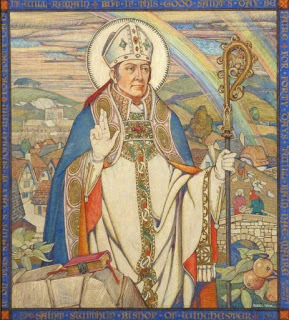
852 Swithun, counselor to Kings Egbert and Aethelwulf, became Bishop of Winchester.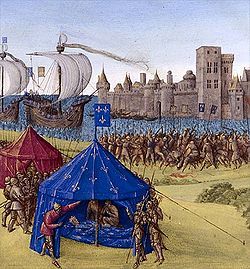
1270 The Eighth Crusade and siege of Tunis ended by an agreement between Charles I of Sicily (brother to King Louis IX of France, who had died months earlier) and the sultan of Tunis.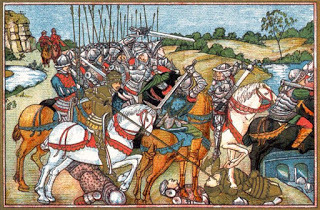
1470 Henry VI of England returned to the English throne after the Earl of Warwick defeated the Yorkists in battle.

852 Swithun, counselor to Kings Egbert and Aethelwulf, became Bishop of Winchester.

1270 The Eighth Crusade and siege of Tunis ended by an agreement between Charles I of Sicily (brother to King Louis IX of France, who had died months earlier) and the sultan of Tunis.

1470 Henry VI of England returned to the English throne after the Earl of Warwick defeated the Yorkists in battle.
Published on October 30, 2015 01:30
October 29, 2015
Were there really only 300 Spartans at the Battle of Thermopylae?
History Extra
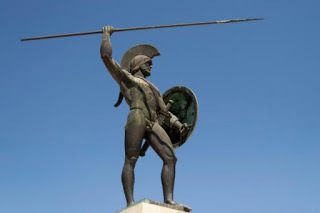
It is considered a heroic last stand by King Leonidas of Sparta and his tiny number of brave warriors against an army of a supposed million soldiers.
This article was first published in March 2014
King Leonidas sculpture in Thermopylae © Santiago Rodríguez Fontoba | Dreamstime.com
Last week saw the release of 300: Rise of an Empire , the sequel to the muscle-rippling, blood-splattering, historically-dodgy 300 – which told the fantastical story of the Battle of Thermopylae in 480 BC, when a handful of Spartans fought the entirety of Persia’s armies for three days. But was it as one-sided as the legend suggests?
In short, not as much as suggested. It is true there were only 300 Spartan soldiers at the Battle of Thermopylae but they were not alone, as the Spartans had formed an alliance with other Greek states. It is thought that the number of Greeks was closer to 7,000. The size of the Persian army is disputed. 5th-century Herodotus claimed there were over two million but it was more likely to be between 100,000 and 300,000, so the Greeks were still against overwhelming odds.
With this huge army, Xerxes I of Persia was intent on invading and conquering all of Greece, but King Leonidas of Sparta met him at the narrow coastal pass of Thermopylae, known as the Hot Gates, where Persia’s superior numbers counted for nothing. A messenger threatened a Spartan general saying, “Our arrows will block out the Sun”, to which the general replied, “Then we will fight in the shade.” Leonidas’ forces held off the Persians for two full days.
The Spartans were brutal warriors, raised never to surrender or show weakness. When a Persian ambassador ordered the Greeks to lay down their weapons, Leonidas hit back with, “Come and take them”.
A Greek called Ephialtes betrayed his country by revealing a path to the Persians that allowed them to outflank Leonidas. The Spartan King dismissed most of the army and formed a rear-guard of around 1,500 men, including his 300 Spartans, 700 Thespians, 400 Thebans and a few hundred others, many of them slaves. They were wiped out but this sacrifice allowed the bulk of the army to retreat and regroup.
Xerxes’ invasion ended in failure as the Greeks won decisive victories at the Battles of Salamis and Plataea.

It is considered a heroic last stand by King Leonidas of Sparta and his tiny number of brave warriors against an army of a supposed million soldiers.
This article was first published in March 2014
King Leonidas sculpture in Thermopylae © Santiago Rodríguez Fontoba | Dreamstime.com
Last week saw the release of 300: Rise of an Empire , the sequel to the muscle-rippling, blood-splattering, historically-dodgy 300 – which told the fantastical story of the Battle of Thermopylae in 480 BC, when a handful of Spartans fought the entirety of Persia’s armies for three days. But was it as one-sided as the legend suggests?
In short, not as much as suggested. It is true there were only 300 Spartan soldiers at the Battle of Thermopylae but they were not alone, as the Spartans had formed an alliance with other Greek states. It is thought that the number of Greeks was closer to 7,000. The size of the Persian army is disputed. 5th-century Herodotus claimed there were over two million but it was more likely to be between 100,000 and 300,000, so the Greeks were still against overwhelming odds.
With this huge army, Xerxes I of Persia was intent on invading and conquering all of Greece, but King Leonidas of Sparta met him at the narrow coastal pass of Thermopylae, known as the Hot Gates, where Persia’s superior numbers counted for nothing. A messenger threatened a Spartan general saying, “Our arrows will block out the Sun”, to which the general replied, “Then we will fight in the shade.” Leonidas’ forces held off the Persians for two full days.
The Spartans were brutal warriors, raised never to surrender or show weakness. When a Persian ambassador ordered the Greeks to lay down their weapons, Leonidas hit back with, “Come and take them”.
A Greek called Ephialtes betrayed his country by revealing a path to the Persians that allowed them to outflank Leonidas. The Spartan King dismissed most of the army and formed a rear-guard of around 1,500 men, including his 300 Spartans, 700 Thespians, 400 Thebans and a few hundred others, many of them slaves. They were wiped out but this sacrifice allowed the bulk of the army to retreat and regroup.
Xerxes’ invasion ended in failure as the Greeks won decisive victories at the Battles of Salamis and Plataea.
Published on October 29, 2015 03:00
History Trivia - Sir Walter Raleigh executed for treason
October 29
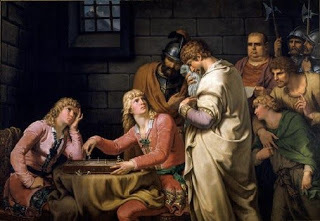
1268 Conradin, the last legitimate male heir of the Hohenstaufen dynasty of Kings of Germany and Holy Roman Emperors, was executed along with his companion Frederick I, Margrave of Baden by Charles I of Sicily, a political rival and ally to the hostile Roman Catholic church.
1618 English explorer Sir Walter Raleigh was executed for treason under a sentence passed 15 years earlier. He was a known writer, poet, soldier, courtier, spy, and explorer who was also largely known for popularizing tobacco in England. He fell out of favor with Queen Elizabeth I when his secret marriage to Bess Throckmorton was discovered. Because they were wed without the Queen's permission, they were imprisoned in the Tower of London. After being released, they retired to his estate at Sherborne, Dorset.

1268 Conradin, the last legitimate male heir of the Hohenstaufen dynasty of Kings of Germany and Holy Roman Emperors, was executed along with his companion Frederick I, Margrave of Baden by Charles I of Sicily, a political rival and ally to the hostile Roman Catholic church.

1618 English explorer Sir Walter Raleigh was executed for treason under a sentence passed 15 years earlier. He was a known writer, poet, soldier, courtier, spy, and explorer who was also largely known for popularizing tobacco in England. He fell out of favor with Queen Elizabeth I when his secret marriage to Bess Throckmorton was discovered. Because they were wed without the Queen's permission, they were imprisoned in the Tower of London. After being released, they retired to his estate at Sherborne, Dorset.
Published on October 29, 2015 00:00
October 28, 2015
UK buyer sought to keep Anglo-Saxon brooch in country
The Guardian
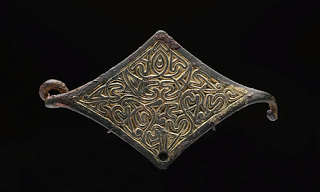 Culture minister has put a temporary export bar on the brooch. Photograph: Department for Culture/PA An elaborate Anglo-Saxon brooch that is more than 1,000 years old may be exported if a UK buyer is not found who will pay at least £8,000 for it.The gilt bronze brooch, from the late 8th century, is one of just 12 such ornaments in existence, and it stands out from the rest for the skill and creativity employed in the creation of its unique complex leaf pattern, which could represent the Christian tree of life.
Culture minister has put a temporary export bar on the brooch. Photograph: Department for Culture/PA An elaborate Anglo-Saxon brooch that is more than 1,000 years old may be exported if a UK buyer is not found who will pay at least £8,000 for it.The gilt bronze brooch, from the late 8th century, is one of just 12 such ornaments in existence, and it stands out from the rest for the skill and creativity employed in the creation of its unique complex leaf pattern, which could represent the Christian tree of life.
An illustration dating from the same period of the Virgin Mary in the Book of Kells shows her wearing a similar brooch, suggesting they were worn by high-status women.
Experts said the brooch is of outstanding significance for the study of Anglo-Saxon art and material culture, but it could be exported unless a UK buyer matches the £8,460 asking price.
Culture minister Ed Vaizey has put a temporary export bar on the brooch in the hope of finding a buyer to keep it in the UK.
He said: “This rare and beautiful brooch gives us a fascinating glimpse into what life was like over 1,000 years ago.
“With an object as old and as rare as this one, it is important that we protect it for the UK in order to help us better understand what life, society and culture was like during Anglo-Saxon times.
“I hope that the temporary export bar that I have put in place will result in a UK buyer coming forward to buy this brooch and save it for the nation.”
Vaizey made the decision following a recommendation by the Reviewing Committee on the Export of Works of Art and Objects of Cultural Interest.
Committee member Leslie Webster said: “This beautiful object has intriguing stories to tell and it would be a marvellous acquisition for a UK museum.”
The decision on issuing an export licence is deferred until 26 January to allow the chance for a UK buyer to come forward, a period that could be extended to 26 March if a serious intention to raise funds to purchase it at the recommended price is made.
 Culture minister has put a temporary export bar on the brooch. Photograph: Department for Culture/PA An elaborate Anglo-Saxon brooch that is more than 1,000 years old may be exported if a UK buyer is not found who will pay at least £8,000 for it.The gilt bronze brooch, from the late 8th century, is one of just 12 such ornaments in existence, and it stands out from the rest for the skill and creativity employed in the creation of its unique complex leaf pattern, which could represent the Christian tree of life.
Culture minister has put a temporary export bar on the brooch. Photograph: Department for Culture/PA An elaborate Anglo-Saxon brooch that is more than 1,000 years old may be exported if a UK buyer is not found who will pay at least £8,000 for it.The gilt bronze brooch, from the late 8th century, is one of just 12 such ornaments in existence, and it stands out from the rest for the skill and creativity employed in the creation of its unique complex leaf pattern, which could represent the Christian tree of life.An illustration dating from the same period of the Virgin Mary in the Book of Kells shows her wearing a similar brooch, suggesting they were worn by high-status women.
Experts said the brooch is of outstanding significance for the study of Anglo-Saxon art and material culture, but it could be exported unless a UK buyer matches the £8,460 asking price.
Culture minister Ed Vaizey has put a temporary export bar on the brooch in the hope of finding a buyer to keep it in the UK.
He said: “This rare and beautiful brooch gives us a fascinating glimpse into what life was like over 1,000 years ago.
“With an object as old and as rare as this one, it is important that we protect it for the UK in order to help us better understand what life, society and culture was like during Anglo-Saxon times.
“I hope that the temporary export bar that I have put in place will result in a UK buyer coming forward to buy this brooch and save it for the nation.”
Vaizey made the decision following a recommendation by the Reviewing Committee on the Export of Works of Art and Objects of Cultural Interest.
Committee member Leslie Webster said: “This beautiful object has intriguing stories to tell and it would be a marvellous acquisition for a UK museum.”
The decision on issuing an export licence is deferred until 26 January to allow the chance for a UK buyer to come forward, a period that could be extended to 26 March if a serious intention to raise funds to purchase it at the recommended price is made.
Published on October 28, 2015 12:08



